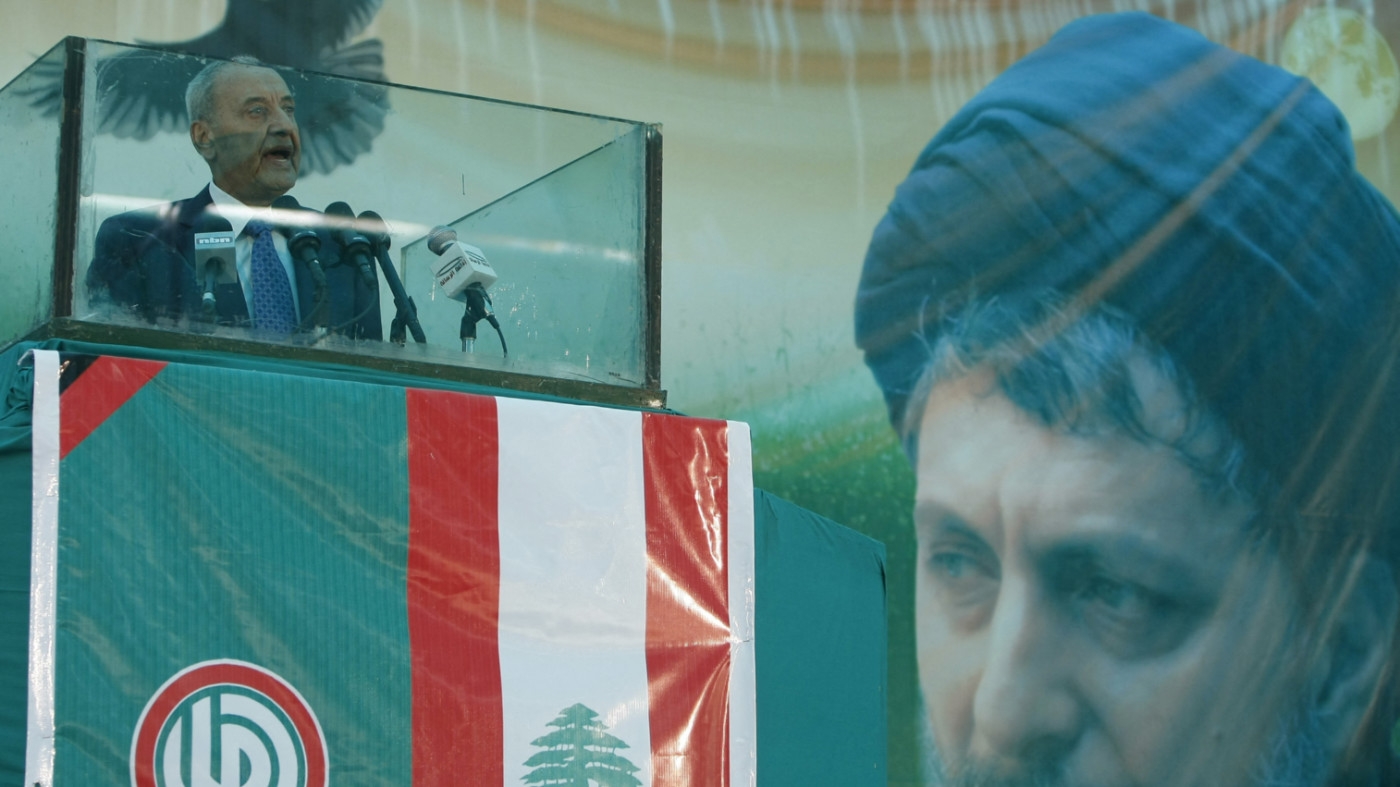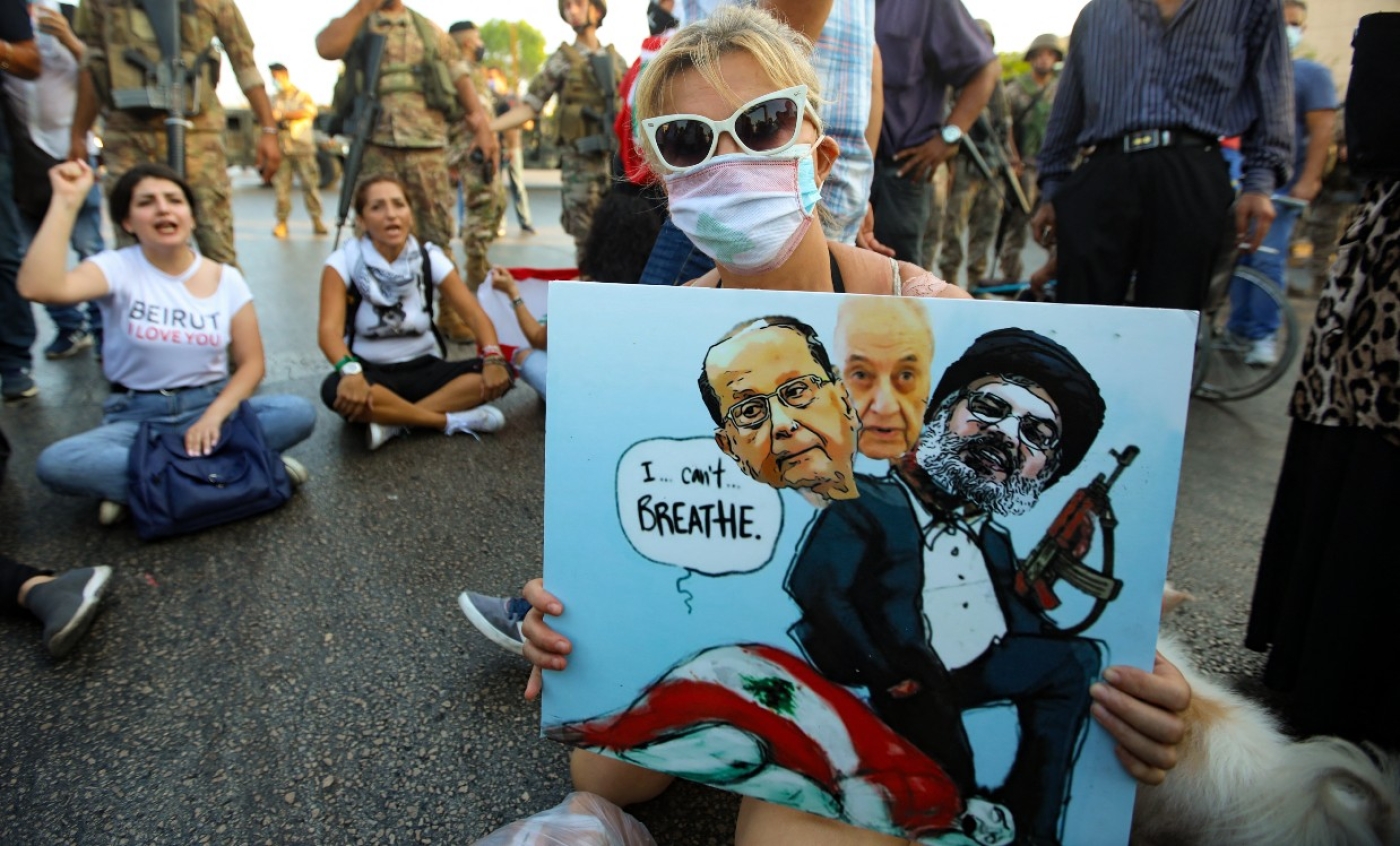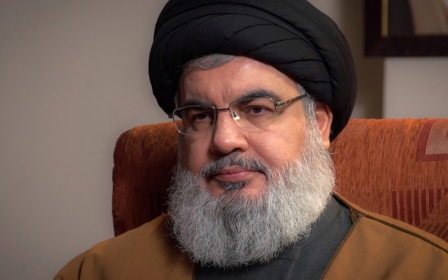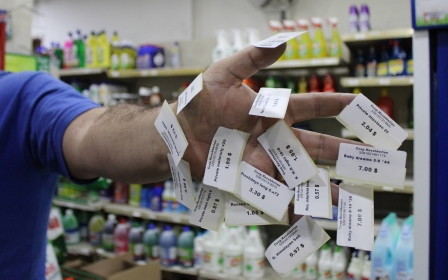Lebanon and politics: Who is Nabih Berri and why does he matter?
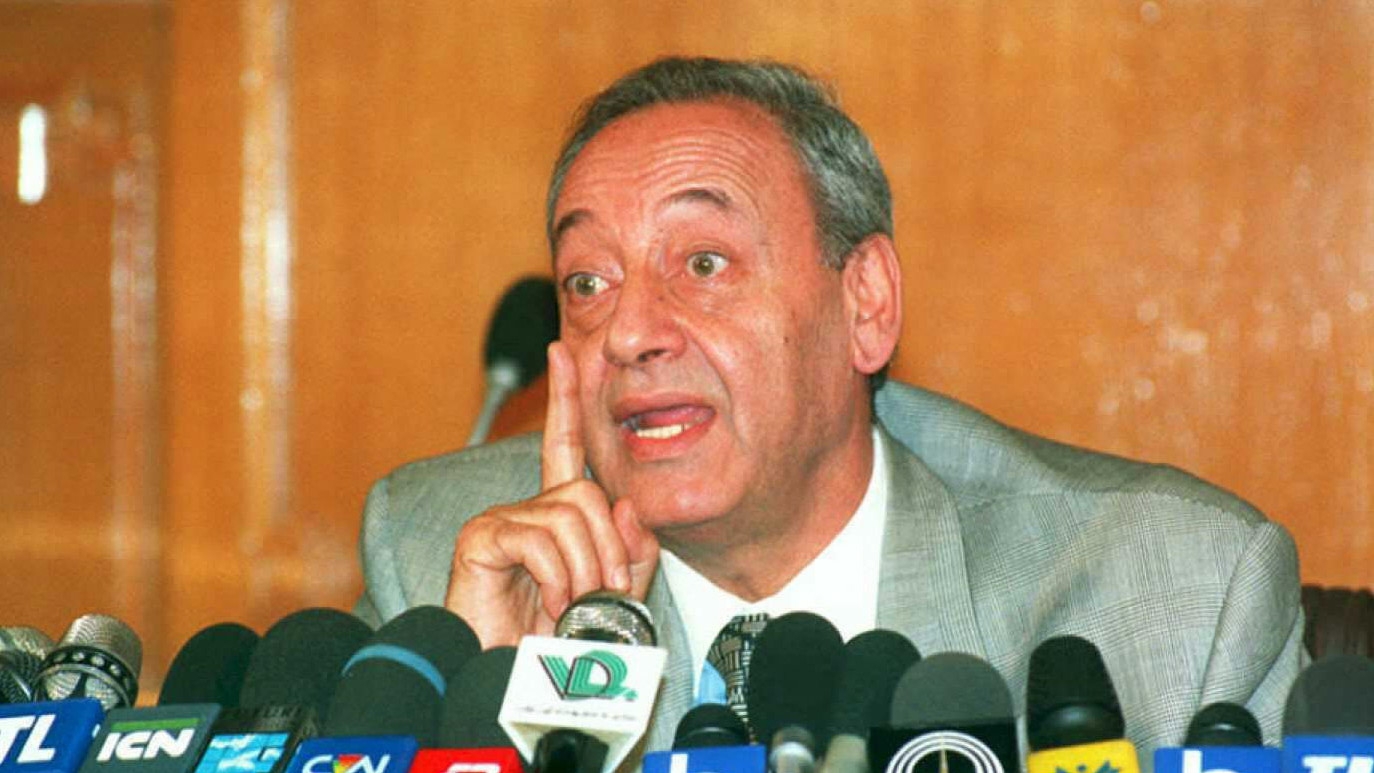
Nabih Berri, long-time speaker of Lebanon’s parliament and leader of the powerful Shia Amal Movement, has changed modern Lebanon during his five-decade political career, fighting for the rights of the country’s marginalised Shia population, and securing them a larger share of political power and access to basic services they had previously lacked.
“From a young age, I committed myself to resist this feudalism,” Berri said in May 2018.
But for many Lebanese, including those protesting on the streets from late 2019 onwards, Berri symbolised an elite political class which for years had failed to provide the country’s five million people with a regular power supply, decent healthcare, or even efficient waste management.
When and where was Nabih Berri born?
Berri was born on 28 January 1938 in Freetown, Sierra Leone, to a Shia family originally from the south Lebanon village of Tibnin. Mustafa, Berri’s father, had moved to Sierra Leone - which has a large Lebanese diaspora community - during the early 20th century and eventually became one of the wealthiest diamond traders in the West African nation.
New MEE newsletter: Jerusalem Dispatch
Sign up to get the latest insights and analysis on Israel-Palestine, alongside Turkey Unpacked and other MEE newsletters
Berri spent his early years in Tibnin, before moving to Beirut for high school, then graduated with a law degree from the state-run Lebanese University. After that, he studied for a year at the Sorbonne in Paris.
In 1963, Berri was elected the president of the National Union of University Students of Lebanon, then worked as a lawyer in Beirut before becoming an early follower of Iranian-born imam Musa al-Sadr. One of Lebanon’s most influential Shia religious leaders during the 20th century, Sadr led a political revival of what had been until then a largely neglected and marginalised community.
In 1974, Sadr launched the Movement of the Deprived to secure a larger share of power for the Shia; and to pressure the state into easing the desperate socioeconomic conditions the community faced in east and south Lebanon.
The movement later took the name of its military wing Amal (an Arabic acronym for "Lebanese Resistance Brigades"), which was formed in July 1975 to protect southern Lebanese villages from Israeli aggression.
How did Nabih Berri rise to power?
During the mid-1970s, many aspiring Shia joined secular left-wing groups and, later, Palestinian forces. In contrast, Berri became a close aide to Sadr and was elected to Amal’s executive council in 1976.
Sadr allied himself and Amal with Syria, which President Hafez al-Assad then ruled. He also backed Damascus’s military intervention in Lebanon during summer 1976 as part of an Arab League initiative to end the year-long civil war.
In August 1978, Sadr disappeared in mysterious circumstances during an official visit to Libya, where he was to meet with leader Muammar Gaddafi. Berri was eventually elected head of Amal in April 1980 and continued to forge links with Syria.
During the first two years of his term, Amal fought against the PLO (Palestine Liberation Organisation) fighters, who were launching rocket salvos and cross-border attacks against Israel from south Lebanon.
Amal often complained that those in the region bore the brunt of destructive Israeli reprisals. “Militants used to flee after firing their rockets and Israel would step in and destroy southern villages with its artillery and jets,” Berri said.
Why did some members of Amal quit and form Hezbollah?
Berri’s first major challenge came in June 1982 when Israel invaded Lebanon and reached Beirut. In what was a watershed moment for Lebanon’s Shia, Berri joined a committee established by President Elias Sarkis which brought together other leaders of Lebanon’s parties involved in the civil war and aimed at reaching a united stance on how to respond to the Israeli invasion.
Other members included Bachir Gemayel, leader of the Lebanese Forces militia, the principal ally of Israel in Lebanon. The committee collapsed later the same month due to sharp disagreements among its members.
The invasion drove the PLO out of Lebanon: Gemayel was elected as president in August 1982, only to be assassinated the following month.
But Berri’s earlier cooperation with Gemayel had other longer-term consequences. Members of Amal, who favoured a closer relationship with Iran’s Islamic Republic, defected and, with support from Tehran, eventually established Hezbollah.
The organisation would eventually develop into Amal’s main foe, although later became a close ally as relations improved. Ultimately, Hezbollah was to become a formidable force in Lebanon and the wider region and eclipse its rival.
How did Berri first become a minister?
Berri continued to rise in prominence alongside Walid Jumblatt, the Progressive Socialist Party leader and began armed opposition during the summer of 1983.
Their chief opponent was new president Amin Gemayel, elected after his brother’s death, and whose government signed a US-brokered peace treaty with Israel on 17 May that year (by this point, US Marines were stationed in Beirut).
The rebellion gained momentum when Amal and PSP militias took control of west Beirut during February 1984, forcing Gemayel to give up on the 17 May agreement.
In spring 1984 French and American multinational forces withdrew: two suicide bombings, believed to have been carried out by Hezbollah, had killed 241 US and 58 French military personnel the previous October.
Also in 1984, Berri was appointed a minister for the first time and put in charge of the Ministry of Energy and Water Resources, the Ministry of Justice and the newly established State Ministry for the South.
Under his supervision, the last of these launched infrastructure and socio-economic development projects in underdeveloped areas, bettering the lives of mostly Shia residents and enhancing Berri’s stature as he competed with Hezbollah for support.
Why did Amal end up fighting the PLO?
In summer 1985, Berri played a key role mediating the release of 39 American hostages, held captive for 17 days by Shia radicals who had hijacked a TWA Boeing 727.
His profile was enhanced further when, together with Jumblatt and Elie Hobeika, leader of the Christian Lebanese Forces militia, he signed a Syrian-brokered agreement to end the civil war in December 1985.
But the tripartite agreement was scuppered when Hobeika was toppled not long afterwards by a rebellion within the ranks of the Lebanese Forces in east Beirut.
Berri and Amal had complicated relationships with their allies: after taking over west Beirut in February 1984, PSP and Amal turned their guns against each other in a struggle for this part of the capital.
The 1980s also witnessed an armed conflict between Amal and the Lebanese Communist Party and several media reports accused Amal of assassinating prominent Marxist intellectuals Hussein Mroueh and Hassan Hamdan (aka Mahdi Amel) in February and May 1987 respectively.
Berri categorically denied these allegations. “I say with clear conscience… that in my entire life, I have neither made a decision nor given an order to liquidate anyone, no matter the magnitude of our rivalry,” he said.
Amal played an active role in the guerrilla war against Israeli troops in the south. But Berri and his backers in Damascus opposed a PLO return to Lebanon to fill the vacuum left by the partial withdrawal of Israeli troops which subsequently followed.
Instead, in what became known as the “War of Camps”, Amal and PLO forces fought three bloody battles in Beirut and the south between 1985 and 1988. The conflict subsided by 1988 and the influence of the powerful Shia families and the left-wing parties dwindled, leaving Berri to confront the group which would become his toughest competition: Hezbollah.
What was Nabih Berri’s relationship with Hezbollah?
By the late 1980s, Hezbollah had established a foothold in southern Lebanon. Amal’s controversial involvement in the “War of Camps” pushed more of its members to defect and join Hezbollah.
Amal and its rival had opposing views about the political orientation of Lebanon’s Shia community, its national and religious identity, and their vision for the future of Lebanon. “I told them [Hezbollah], you came out of our rib, but our children are ungrateful,” Berri said during the war with Hezbollah in 1990.
The two groups fought intermittently until Syria and Iran brokered a deal in November 1990 and brought the battles to an end.
In memoirs published in 2004, Berri called the war with Hezbollah “a dark era which I have no doubt that the brothers in Hezbollah do not like to talk about and this applies to me as well.”
How is Nabih Berri’s relationship with Iran?
Berri’s relations with Iran’s Islamic Republic have sometimes been complicated: he frequently complained that Tehran favoured Hezbollah over Amal, but relations eventually improved by 1990.
Berri backed Ayatollah Ruhollah Khomeini, founder of Iran’s Islamic Republic, and sent fighters as support during the eight-year war in the 1980s between Baghdad and Tehran.
But Berri did not embrace Khomeini’s interpretation of the Shia doctrine of velayat-e faqih (wilayat al-faqih in Arabic), under which Iran’s supreme leader is entitled to religious as well as political authority over all Muslims of the world. Nor did he want Lebanon to be part of an Islamic republic, as advocated by Tehran and Hezbollah.
At the same time, and despite some initial reservations, Berri expressed support for the Syrian-Saudi-US brokered Taif agreement of October 1989, which finally ended Lebanon’s civil war the following year.
The deal further cemented Lebanon’s already sectarian political system but also stipulated a never-implemented road map to abolish the allocation of political and public posts according to faith, which had existed since 1926.
Throughout his career, Berri made a point of regularly calling for the immediate abolishment of political sectarianism or for a transitional period during which the Shia community would receive a larger share of political power.
“A nation is either built based on merit, justice and equality among the Lebanese, ie the abolishment of political sectarianism, or it is built based on justice among sects,” he told a news conference in 1985. “It would be better for Lebanon if all Lebanese were treated equally and political sectarianism was abolished.”
In what was his crowning political achievement, Berri was elected as parliamentary speaker in 1992 and has been re-elected to the same post six times since then. But from then onwards, the implicit division of labour between Amal and Hezbollah crystalized, as the former occupied public sector posts and government positions reserved for the Shia community, while the latter led armed resistance against the Israeli occupation of the south.
Why did Nabih Berri become close to Hezbollah?
When Prime Minister Rafic Hariri was assassinated in 2005, followed by the Syrian army’s withdrawal from Lebanon, Berri shifted his alliance closer to Hezbollah.
Often referred to as the “Shia duo”, Amal and Hezbollah formed the most important pillars of what is known as the “March 8” alliance which, backed by Damascus and Tehran, opposed the pro-western March 14 coalition.
To his credit, in the turmoil after 2005, Berri mastered his role as a mediator between the two alliances. Known for his sharp sense of humour, eloquence and impressive negotiation skills, he maintained friendly ties with politicians from across the spectrum.
He retained a major say in the nomination of presidents, the formation of governments and the passage of legislation. His residence in the upscale Beirut neighbourhood of Ain al-Tineh has been a regular destination for foreign diplomats and senior officials.
Why did some of the public turn against Nabih Berri?
The 2011 uprising in Syria and the subsequent degeneration into civil war saw Berri’s alliance with Damascus pushed to the background. And while he continued to support President Bashar al-Assad, the Amal leader refrained from publicly visiting the Syrian capital: unlike the Hezbollah leadership, Berri also shied away from asking his movement to take part in the fighting in the neighbouring country.
With its members occupying senior government and public sector positions after the civil war, Amal has been accused of corruption. Critics include the protesters who took to the streets in a wave of anti-establishment protests that engulfed much of Lebanon during the autumn of 2019 and subsequently became known as the October 17 revolution. More than once, Berri’s supporters fought back by violently harassing the demonstrators.
The speaker was also accused by some rivals and critics of disrupting the probe into the Beirut port blast of August 2020 which killed 220 people. Former ministers Ali Hassan Khalil and Ghazi Zeaiter, who are loyal to Berri, refused to be interrogated by Judge Tarek Bitar who is still investigating what happened. Amal, Hezbollah and other allies have in turn accused Bitar of bias and overstepping his powers.
Other members of the public point to Amal’s share of the responsibility in the unprecedented economic crisis Lebanon has endured since 2019, which has seen the lira collapse and people's savings wiped out. Khalil was finance minister between 2014 and 2020.
But in a May 2022 speech, Berri denied any corruption or wrongdoing and said Amal was ready to accept any verdict against it. “The previous phase, starting [with the events of] October 17 [2019] and the aftermath of the Beirut port blast has seen hateful sectarian incitement and slander against the Amal movement and its history,” he said. “In the name of the [Shia] duo I say let the judiciary decide and no one [who proves to be guilty] will be protected.”
But many Lebanese question the credibility of the judiciary in a country known for its impunity.
What will be Nabih Berri’s legacy?
Throughout five decades of an eventful political career, Berri has been the driving force behind far-reaching changes within Lebanon’s Shia community and the country’s political history.
By spearheading an armed rebellion against Gemayel in the years 1983 and 1984, he shaped the trajectory of Lebanese foreign policy for decades to come. Backed by Jumblatt, local allies, Syria and the USSR, his violent opposition killed off the May 17 peace treaty between Lebanon and Israel and moved Beirut closer to Damascus.
His sponsorship of armed resistance against Israel and his ironclad alliance with Hezbollah after internecine fighting also paved the way for the liberation of south Lebanon in May 2000 and the emergence of Hezbollah as the world’s most powerful paramilitary group.
For the Shia, he killed off centuries-old Shia feudalism, enfeebling powerful families such as that of former Speaker of Parliament Kamel Al-Asaad. As a government minister, parliamentary speaker and party leader, he alleviated socioeconomic hardship with the construction of schools, hospitals, water tanks, roads and other infrastructure projects in the south.
But for other Lebanese, Berri began to resemble part of a political elite, the sort that his very own movement opposed during the civil war, and which had failed to establish either a functioning political system or an efficient government capable of providing essential services.
Who is likely to be Nabih Berri’s successor?
Berri, now in his late 80s, has six daughters and three sons from two marriages. His youngest son Bassel has shown interest in politics, often appearing at Amal rallies and ceremonies: in a country where political dynasties dominate public life, this has raised speculation as to whether he is being to succeed his father.
But Berri credits himself with eradicating Shia feudalism, and more than once categorically denied plans for any familial succession.
“I eradicated political feudalism and we are a political movement with an organized structure, he told an interviewer in May 2018, “ and so it is the movement which will inherit me [elect my successor].”
Middle East Eye delivers independent and unrivalled coverage and analysis of the Middle East, North Africa and beyond. To learn more about republishing this content and the associated fees, please fill out this form. More about MEE can be found here.


